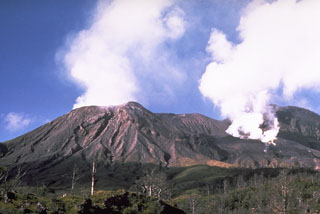Report on Langila (Papua New Guinea) — March 1996
Bulletin of the Global Volcanism Network, vol. 21, no. 3 (March 1996)
Managing Editor: Richard Wunderman.
Langila (Papua New Guinea) Vulcanian explosions continue
Please cite this report as:
Global Volcanism Program, 1996. Report on Langila (Papua New Guinea) (Wunderman, R., ed.). Bulletin of the Global Volcanism Network, 21:3. Smithsonian Institution. https://doi.org/10.5479/si.GVP.BGVN199603-252010
Langila
Papua New Guinea
5.525°S, 148.42°E; summit elev. 1330 m
All times are local (unless otherwise noted)
Moderate explosive activity continued at Crater 2 during March, however, there was possibly a slight decline compared to last September. Intermittent Vulcanian explosions released ash clouds that rose several hundred meters above the crater. These explosions resulted in minor ashfalls to the volcano's SE. A weak but steady crater-glow was observed on a few nights. In accord with these observations, 6-30 daily explosion earthquakes registered at a station 4 km away. There was no visible activity from Crater 3.
Geological Summary. Langila, one of the most active volcanoes of New Britain, consists of a group of four small overlapping composite basaltic-andesitic cones on the lower E flank of the extinct Talawe volcano in the Cape Gloucester area of NW New Britain. A rectangular, 2.5-km-long crater is breached widely to the SE; Langila was constructed NE of the breached crater of Talawe. An extensive lava field reaches the coast on the N and NE sides of Langila. Frequent mild-to-moderate explosive eruptions, sometimes accompanied by lava flows, have been recorded since the 19th century from three active craters at the summit. The youngest and smallest crater (no. 3 crater) was formed in 1960 and has a diameter of 150 m.
Information Contacts: Ben Talai, RVO.

